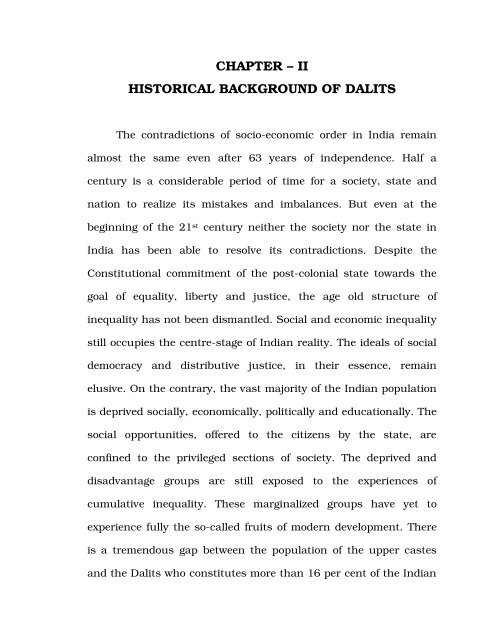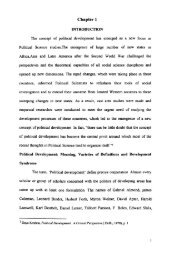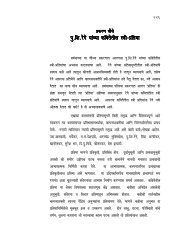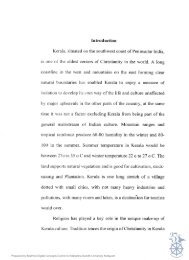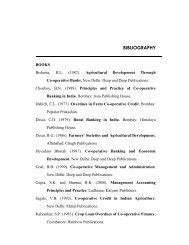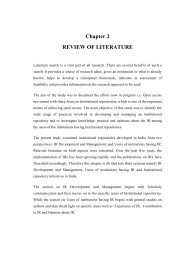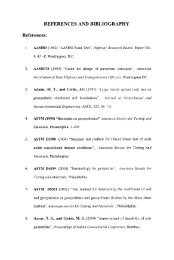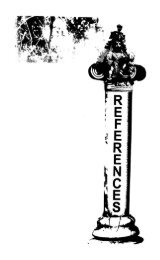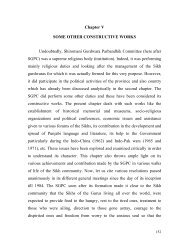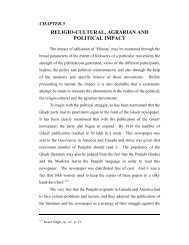CHAPTER – II HISTORICAL BACKGROUND OF DALITS
CHAPTER – II HISTORICAL BACKGROUND OF DALITS
CHAPTER – II HISTORICAL BACKGROUND OF DALITS
Create successful ePaper yourself
Turn your PDF publications into a flip-book with our unique Google optimized e-Paper software.
<strong>CHAPTER</strong> <strong>–</strong> <strong>II</strong><br />
<strong>HISTORICAL</strong> <strong>BACKGROUND</strong> <strong>OF</strong> <strong>DALITS</strong><br />
The contradictions of socio-economic order in India remain<br />
almost the same even after 63 years of independence. Half a<br />
century is a considerable period of time for a society, state and<br />
nation to realize its mistakes and imbalances. But even at the<br />
beginning of the 21 st century neither the society nor the state in<br />
India has been able to resolve its contradictions. Despite the<br />
Constitutional commitment of the post-colonial state towards the<br />
goal of equality, liberty and justice, the age old structure of<br />
inequality has not been dismantled. Social and economic inequality<br />
still occupies the centre-stage of Indian reality. The ideals of social<br />
democracy and distributive justice, in their essence, remain<br />
elusive. On the contrary, the vast majority of the Indian population<br />
is deprived socially, economically, politically and educationally. The<br />
social opportunities, offered to the citizens by the state, are<br />
confined to the privileged sections of society. The deprived and<br />
disadvantage groups are still exposed to the experiences of<br />
cumulative inequality. These marginalized groups have yet to<br />
experience fully the so-called fruits of modern development. There<br />
is a tremendous gap between the population of the upper castes<br />
and the Dalits who constitutes more than 16 per cent of the Indian
population. The upwardly mobile other backward castes have, of<br />
course, challenged the hegemonic structure of the upper castes<br />
(Brahminical) order and they have crystallized themselves as a<br />
major economic and political power in independent India. But as<br />
far as the social status of Dalits is concerned, no substantial<br />
changes have taken place during the six decades of development<br />
planning. They are still rated at the underside in the socio-<br />
economic structure.<br />
It is widely acknowledged that traditional Indian society was<br />
based on varna and jati. This system is very ancient in origin and<br />
through the passage of time it has undergone profound changes,<br />
but caste still a very powerful institution in our socio-economic ,<br />
religious and political organization. The most disquietening and<br />
disturbing feature connected with the caste system has been the<br />
concept of untouchability. Those who were engaged in unclean<br />
occupation were considered as polluted persons and had to go with<br />
this stigma in the prevailing reality and had to accept for<br />
themselves the status of untouchables. 1<br />
Over the period of time, the various social and religious<br />
movements strived to make a dent in the social system in favour of<br />
the Dalits. Several saints, social reformers and political leaders<br />
from both the Dalits and non-Dalits had tried their best for the
eradication of untouchability from the social fabric. 2 But the impact<br />
of some reform movements was short-lived because the reformers<br />
fought within the caste system. However, their attempt was to<br />
facilitate certain caste groups simply to move up within the caste<br />
hierarchy through sanskritization. 3 In fact, these movements were<br />
reform oriented rather than providing protection against the<br />
existing inequality in the social system.<br />
In this regard, the efforts by Ambedkar and Gandhi, before<br />
and after independence in India, are important. The difference<br />
between the two leaders, were on the basis of their approaches in<br />
tackling the problem of untouchability and upliftment of the<br />
untouchables. Gandhi who described himself as an untouchable by<br />
choice 1 attempted to solve the problem within the framework of<br />
caste system. But he could neither change the attitude of caste<br />
Hindus nor satisfy the untouchables as the practice of<br />
untouchability and discrimination continued to operate against the<br />
Dalits. On the other hand Ambedkar was totally opposed to<br />
Gandhi's philosophy and programme for the removal of<br />
untouchability. He stated "to the untouchables Hinduism is a<br />
veritable chamber of horrors. The sanctity and infallibility of the<br />
Vedas, Smiritis, Shastra, the Iron law of caste, the heartless law of<br />
Karma and the senseless low status by birth are to the
untouchable's veritable instruments of torture which Hinduism has<br />
forged against the untouchables. These very instruments which<br />
have multilated, blasted and blighted the life of the untouchables,<br />
are to be found intact and untarnished in the blossom of<br />
Gandhism". 4 Ambedkar felt that the problem of the untouchables<br />
was economic, social and political as well as religious that widely<br />
prevailed in India even then. 5<br />
Caste System and Dalits<br />
Indian social structure has its unique place in the world,<br />
primarily because of its caste system. Several social scientists have<br />
made in-depth studies on this Indian social system. Although the<br />
social scientists have done much work on the Indian caste system,<br />
but they have found it difficult to define it. Some scholars hold that<br />
caste is a particular rigid form of class and think its existence to be<br />
world wide while others believe it is to be a system peculiar to India<br />
and its environs.6<br />
The English word caste is probably derived from the<br />
Portuguese word casta (race). It is especially used by Europeans to<br />
denote the different classes into which the Hindus are divided.<br />
Varna, colour, jati, race, are Indian names. 7 The word seems to<br />
have applied to India by the Portuguese in the middle of 15 th<br />
century. 8 In English there is a use in the sense of 'race' in 1555 and
the Indian sense is encountered at the beginning of the seventeenth<br />
century, the French spelling Caste is, scarcely found before 1800. 9<br />
The word 'caste' is used in everyday life and we use it to distinguish<br />
from one person to another.<br />
The first literary traces of the caste system were found in<br />
Rigveda and Pursasukta hymn. 10 In the Bhagavad Gita the caste<br />
system is sought to be justified on the basis of the idea of Guna<br />
Karma (deed) and Dharma (Religion). 11 In the age of Simritis and<br />
Sutras, the society had been divided into various castes. 12 They had<br />
framed hard and fast rules regarding occupation, food conduct and<br />
marriage. In the same age, these castes became so diversified that<br />
they could not meet together in course of time. The feeling of<br />
untouchability also grew in this age. 13<br />
Untouchability is undoubtedly the most pernicious aspect of<br />
the caste system. Its origin is obscure and is a matter of<br />
controversy to this day. To Iravati Karve it is a sub-caste of<br />
Shudras, 14 whereas Ambedkar regarded it as a bye product of the<br />
caste system. 15 There is however general unanimity of opinion as to<br />
non-existence of untouchability during the Vedic period. 16<br />
Words such as Varna, Jati, biradri and samaj are used<br />
interchangeably with the term caste . All of these terms refer to
anked groups of various size and breadth. Varna meaning colour,<br />
actually refers in large divisions that include various castes; the<br />
other terms include caste and sub divisions of castes, sometimes<br />
called sub-cates. 17<br />
The 'Varna' model provide a framework within which the<br />
innumerable variations of caste throughout India are found. The<br />
varna scheme is a hierarchy in the literal sense of the term because<br />
the criteria of ritual purity and pollution are at the basis of<br />
differentiation. 18 Each caste ranked higher or lower on the basis of<br />
the ritual purity. The description of caste model in its extreme form<br />
is that one's caste position in a ritually determined status-<br />
hierarchy defines one's total life. 19 There is some correlation<br />
between ritual rank in the caste hierarchy and economic<br />
prosperity. Member of higher castes tend, on the whole, to be more<br />
prosperous than members of lower ranking castes. Most of the<br />
castes are traditionally associated with an occupation, such as high<br />
ranking- Brahmins, middle ranking - farmers and Artisan groups,<br />
and very low ranking- Dalits: leatherworkers, butcher, latrine<br />
cleaners. These low ranking jobs are low paid, therefore, many<br />
lower caste people live in conditions of poverty and social<br />
disadvantage. 20
Caste dominate people's lives from birth to death in India.<br />
The understanding of the caste system which controls and<br />
regulates social, economic, political and religious life in India is<br />
absolutely essential while interpreting the Indian reality. It is true<br />
that social and racial differences in some form or the other do<br />
prevail in other parts of the world, but the kind of system found In<br />
India is characterized more by its specific unique features like the<br />
complexity, elaboration and rigidity than by such features which<br />
share with caste structures elsewhere. 21<br />
The stratification of Indian population into groups is defined<br />
by caste, which is determined by birth. An individual is born into a<br />
caste and his status in society depends largely upon the caste to<br />
which he/she belongs and not on his/her personal success or<br />
failure. The reason of the permanence of caste system in India is<br />
the unity of social and religious rules. No rule of social order is<br />
distinct from the religious rules. 22<br />
Considering the background of social change, some people<br />
believe that the system of caste is on the way out, others believe<br />
that inspite of external features, the caste has retained most of its<br />
essential functions. Many social reformers, political and social<br />
scientists have expressed their concerns about the increasing
influence of caste on politics and many other spheres of social life.<br />
M.N. Srinivas, the well known anthropologist, is a major proponent<br />
of the view that 'the caste system in India is not declining but<br />
growing more powerful. Modern means of communication, the<br />
spread of education and an increase in prosperity have contributed<br />
to the strengthening of the caste system, especially through the<br />
formation of caste associations which cover large area and utilize<br />
the means of communication and organization made available<br />
through technological progress in order to strengthen their hold<br />
upon members of the caste and to mould their activities.' 23 More<br />
and more is being written on the caste system by scholars.<br />
Although scholars have done much work on the Indian caste<br />
system, they find difficult to define it. They also differ on the<br />
meaning of caste.<br />
According to Risley caste is a collection of families or groups<br />
of families bearing a common name; claiming a common descent<br />
from a mythical ancestor; human or divine professing to follow the<br />
same hereditary calling; and regarded by those who are competent<br />
to give opinion of forming a single homogenous community. The<br />
name generally denotes or is associated with a specific occupation.<br />
A caste is almost invariable endogamous in the sense that a
member of the large circle denoted by a common name may not<br />
marry outside that circle, but within the circle there are usually a<br />
number of smaller circles each of which is endogamous. 24<br />
Ketkar defines a caste as ' a social group having two<br />
charactericts (i) membership is confined to those who are born of<br />
members and includes all persons so born (ii) the members are<br />
forbidden by an inexorable social law to marry outside the group.<br />
Each one of such groups has a special name by which it is called<br />
several of such small aggregates are grouped together under a<br />
common name, while these larger groups are but subdivisions of<br />
groups still larger which have independent names. 25<br />
According to Beteille caste is a small and named group of<br />
persons characterized by endogamy, hereditary membership, and a<br />
specific style of life which sometimes includes the pursuit by<br />
tradition of a particular occupation and is usually associated with a<br />
more or less distinct ritual status in a hierarchical system. 26<br />
According to Majumdar "if a number of people constitute a group,<br />
not because of physical togetherness but because they have some<br />
common interests and common ways of doing things, as a<br />
consequence of which stratification of society into higher and lower<br />
groups emerges, then these groups may be called status groups. If
a status group is open to entry, that is, if anybody can become its<br />
member by fulfilling certain prerequisite conditions, like obtaining<br />
a degree, or paying an admission fee, or earning a particular<br />
income, the status group may be called a class. The restrictions of<br />
the term class to mean an income group has no sociological<br />
sanction: such a group is properly called an economic class. If the<br />
recruitment is not free, that is, a status group is not open to<br />
anybody, but only those are its members who have certain ascribed<br />
attributes, which cannot be acquired by others, then it is called a<br />
caste." 27 G.S. Ghurye, has defined caste and enlisted its six<br />
outstanding characteristics: Endogamy, Hierarchy, Restrictions on<br />
consensual relations between castes, Restriction on choice of<br />
occupation, Civil and religious disabilities and Privileges of certain<br />
groups, and Untouchability. It follows that membership is fixed for<br />
life, because the individual cannot alter his caste by any effort of<br />
his own. Further he makes a distinction between caste societies<br />
and class societies by arguing that 'the status of a person in a caste<br />
society depended not on his wealth as in the classes of modern<br />
Europe, but on the traditional importance of the caste in which he<br />
had the luck of being born. 28
J.H. Hutton points out that caste provides the individual<br />
members with a fixed social milieu, a prominent body of association<br />
which controls almost all his behaviour and contacts. 29<br />
A.R. Desai has described the social structure stratified into<br />
the divisions identified as castes. He that writes the castes<br />
constituting the series were hierarchically graded and each caste<br />
being considered inferior to those above it and superior to those<br />
below it. The status of a man born in a particular caste was<br />
determined by the rank of that caste in this hierarchy. Once born<br />
in that caste his status was predetermined and immutable. His<br />
birth decided his status which could not be altered by any talent he<br />
might show or wealth he might accumulate. 30<br />
However, we need not go into a detailed discussion regarding<br />
the origin of caste system and the different theories put forth by the<br />
scholars regarding it. The different theories, mentioned above,<br />
show that only one or two factors cannot be indicated as probably<br />
contributing to the emergence and development of the caste system<br />
in India. Caste system is commonly viewed as an hierarchical<br />
system. It also evinces some of the properties of a segmentary<br />
system i.e. there are several levels of differentiation and these levels<br />
are related to each other in specific ways. First, membership in a
caste is by birth; second, a caste is an endogamous unit; third,<br />
members of each caste traditionally had an occupation or trade to<br />
pursue; fourth, castes are graded in a local hierarchy and fifth,<br />
notions of pollution and purity govern the nature and extent of the<br />
relationships between castes. 31 To sum-up, the caste system is a<br />
segmental division of society into endogamous, hereditary descent<br />
groups. These groups constitute a hierarchy in which the Brahmins<br />
occupy the top position and the Dalits the bottom one.<br />
Existence of caste system gives a distinctive identity to Indian<br />
society amongst the traditional social systems of the world. At the<br />
beginning, the caste system was apparently an arrangement for the<br />
peaceful coexistence of several clans, tribes or other social groups.<br />
But, with the passage of time, it developed rigidity and caste and<br />
communities multiplied themselves on the basis of occupation and<br />
other considerations. 32 The differentiations in status, based on<br />
caste, creed or occupation has transformed our society into<br />
somewhat closed stratified system. 33 Another point that caste<br />
system is very significant is because it was linked with various<br />
aspects of an individual's life i.e. economic, political, religious, legal<br />
and moral etc. In so far as the life of the average people is<br />
concerned, religious, rituals and caste obligations still matter very
much. 34 The caste system divided the whole society into a large<br />
number of hereditary groups, distinguished from one another and<br />
connected together by three characteristics i.e.<br />
(i) separation in matters of marriage and contact whether<br />
direct or indirect;<br />
(ii) division of labour, each group having, in theory or by<br />
tradition, a profession; and<br />
(iii) finally hierarchy, which ranks the group as relatively<br />
superior or inferior to one another. 35<br />
Thus characteristic features of the caste system are its strict<br />
hierarchical organization and that each caste is tied to a particular<br />
profession.<br />
The social distance between the caste groups varies from<br />
state to state, but generally there is well established hierarchy of<br />
castes that can be considered under four broad headings, namely-<br />
Brahmins, Kshatriyas, Vaisyas and Shudras and such a<br />
stratification can be traced back to Vedas. 36<br />
In Rigveda period, the earliest work of the first three classes<br />
of society are very frequently mentioned, and named Brahma,<br />
Kshatra, and Visha. It is only in one of the later hymns, the<br />
celebrated Purushasukta, that a reference has been made to four
orders of society as emanating from the sacrifice of the primeval<br />
being. The names of those four orders are given there as<br />
Brahimana, Rajanya, Vaishya, and Shudra. 37 Further, M.N.<br />
Srinivas writes, "In the Rigvedic hymn Purushasukta, the four<br />
varna or order formed the limbs of primeval man (Purusha), who<br />
was victim in the divine sacrifice which produced the cosmos. The<br />
Brahmin emerged from his mouth, the Kshatriyas from his arms,<br />
the Vaishyas from his thighs and the Shudras from the feet". 38 The<br />
first three castes are twice born or Davija since the men from these<br />
castes are entitled to use the sacred thread at the Vedic rite of<br />
Upanayana, which the Sudras were not allowed to perform. 39<br />
It is not only that these four varnas have been mentioned in<br />
the sacred texts, but they have also been assigned their duties as<br />
well. The Brahmins was directed to the ritual process which was<br />
associated with pastoral or agricultural work, the Kshatriya<br />
defended the territory and also conduct fire scarifies for the<br />
prosperity of his subjects, the Vaishya looked after economic<br />
exchange of goods and service and management of livestock and<br />
the Shudra toiled in the field and rendered services such as<br />
delivering message etc. 40 It appears that the major stratification in<br />
term of caste was originally based on occupational division without<br />
a vertical social hierarchy. 41
Shudras were considered clearly inferior to the other three<br />
castes and were constrained to perform only menial jobs. Those<br />
doing menial jobs obviously had low status. A person who had a<br />
low status in the caste hierarchy also had low status in other<br />
hierarchy of the society such as economic or political.<br />
Since Dalits were assigned the duties of serving the other<br />
three Varnas, they were deprived of higher training of mind and<br />
were denied social status. Although in the beginning, the caste<br />
system was merely based upon division of labour for the purpose of<br />
fixing responsibility and duty, yet with the passage of time, it<br />
degenerated into pathogenic affairs where occupations changed<br />
into castes. The higher castes of the society looked down upon the<br />
Shudras. It was a general belief that the Dalits are part of the<br />
lowest of low Varnas.<br />
Thus for centuries Dalits have been positioned at the bottom<br />
of the rigid Indian caste society. People from other castes, who<br />
considered themselves to be higher, believe that Dalits are impure<br />
by birth and that their touch or sheer presence could be polluting<br />
hence, they are assumed to be untouchable. 42 For centuries, Dalits<br />
were excluded from the mainstream society and were only allowed<br />
to pursue menial occupations like cleaning dry latrines, sweeping,
tanning or working as landless labour for meager daily wages. 43<br />
Almost in whole of the ancient period, they were the people who<br />
cultivated the land, mended the shoes, washed the clothes, made<br />
the ropes, cleaned the streets and did all types of menial works. 44<br />
Dalits were discriminated in every sense. They lived in the<br />
Hindu villages hence did not have advantage of geographical<br />
isolation like tribes. They were to serve all classes of people around<br />
and had to do all the dirty jobs. They were barred to enter in<br />
society in every sense, they were prohibited to wear decent dress<br />
and ornaments besides being untouchable in every sense. .<br />
The first three upper castes were subsequently designated<br />
"dvija"- twice born, and were entitled to wear a sacred thread<br />
across the chest and over one shoulder as a badge of their nobility.<br />
They also enjoyed the exclusive privilege of studying the holy<br />
Vedas, the Sudras being permitted neither to open a page of sacred<br />
book, nor even to listen to the reading thereof. 46<br />
Many of the atrocities were committed in the name of religion,<br />
like pouring molten lead into the ears of a Dalit, who happened to<br />
listen to some mantra. To retain the stronghold on people,<br />
education, especially religious education, was the monopoly of the<br />
Brahmins. 47
The two great epics, the Ramayana and the Mahabharata,<br />
describe further deterioration of the Dalits' condition. Indeed, a<br />
story from the Ramayana shows how even to the Sudras had<br />
become degraded in the Rama's time only. The three upper castes<br />
were allowed to do Tapasya (Penance and meditation), when one<br />
Sudras by the name of Samvuka nevertheless undertook penance<br />
in order to attain divinity, a 15 year old Brahmin boy died as a<br />
result. When lord Rama came to know about this, he went to meet<br />
him. The ascetic replied. "O King ! I am born of Shudra caste. I<br />
want to attain divinity by such penance. Because I want to attain<br />
divinity, I will not tell lies. I am a Sudra by caste and my name is<br />
Samvuka."As soon as the ascetic uttered these words Lord Rama<br />
drew his sword and severed Samvuka's head. 48<br />
Another story of the Mahabharata also illustrates the<br />
degraded status of the Dalits. Ekalavya, an indigenous boy, had to<br />
have his right thumb cut off because he had learnt archery so well<br />
that his skill equaled that of Arjuna." 49 The point is that Dalits in<br />
the past had no access to education. The road to knowledge was<br />
closed for them. As a consequence, these castes remained socially,<br />
economically and educationally backward.
The higher castes of society looked down upon the Dalits.<br />
They gave them the title of untouchables because of their total<br />
exclusion. They did not allowed Dalits to enter in the temples and<br />
barred them from fetching the water from the common well and<br />
from using the common facilities.<br />
Thus, for years, the Dalits suffered from social injustices and<br />
exploitations so as to prevent them from rising above the social<br />
status fixed for them. The Dalits being on the lowest rung of the<br />
social ladder were denied entry into several occupations which were<br />
relatively cleaner. They were associated with a variety of specialized<br />
traditional occupations such as scavenging, cobbling and disposal<br />
of carcasses etc.<br />
While discussing the low position of these groups Blunt says<br />
'At all times, the Brahmin priesthood has endeavoured to keep<br />
them segregated, not only from the society, but from the Hindu<br />
religion and the Hindu ceremonies; they were not allowed to hear,<br />
much less study the Vedas; they must not enter the temples; they<br />
must carry on all ceremonies without using the mantras and no<br />
Brahmin would carry out any domestic ceremony for them. 50<br />
Thus, we can conclude that Dalits suffered oppression at the<br />
hands of the upper castes for centuries; their economic condition<br />
remained bad, they were educationally backward and they lacked
political skills to hold their own self against the upper caste<br />
leadership of the country. In brief, the low rank of the Dalits<br />
resulted from cumulative inequalities in economic, political and<br />
cultural system.<br />
Dalit Movements and Organizations in India<br />
The problem of untouchability and exploitation of Dalits in<br />
social, economic and political areas has been a stark reality of<br />
Indian society. Various efforts have been made so far by<br />
visionaries in this direction by launching movements and forming<br />
organizations to highlight and find solution of the problems of the<br />
Dalits in India. As a result we can see a constant growth of<br />
awareness among the Dalits who have started asserting their<br />
identity and demanding their due share in power. Here an attempt<br />
has been made to give an account of various Dalits movements<br />
and organizations in India.<br />
If we look at the history of Dalit movements organized in<br />
different parts of the country, it becomes clear that a number of<br />
socio-political organizations, struggles and various types of<br />
activities of the Dalits had emerged out of different socio-economic<br />
and political conditions in the past to ameliorate their wretched<br />
condition. 51 These movements have led to some alleviation in the
plight of the Dalits and resulted in breaking of various social<br />
barriers.<br />
A number of leaders raised their voice against the upper caste<br />
exploitation of the Dalits. Jyotiba Phule, E.K. Nayar, B.R.<br />
Ambedkar, M.K.Gandhi, Mangoo Ram etc. were particularly<br />
noticeable for their struggle for the Dalits. Mahatama Jyotiba Phule<br />
was the first leader of notice to emerge, who worked to uplift the<br />
Dalits and fought for their rights. 52 After Mahatama Jyotiba Phule,<br />
B.R. Ambedkar, well known as Constitution maker and ‘MESSIAH’<br />
of Dalits, represented the Dalits at Round Table Conference in<br />
London. It is to be noted that before Ambedkar the personalities<br />
who raised their voice against the society did that from the social<br />
aspect but Ambedkar did the same from the social as well as<br />
political aspect. In 1932, British Government presented the<br />
‘Communal Award’ concerning the depressed classes. In this Award<br />
two types of vote system and separate electoral was awarded. 53<br />
Ambedkar wanted a guarantee for Dalits as a pre-condition of self<br />
rule. But M.K. Gandhi was against the separate representation of<br />
Dalits and he had to resort to fast unto death. Initially, Ambedkar<br />
was against Gandhi’s proposition. But later on they agreed with<br />
each other and reached at the connivance which is known as
‘Poona Pact'. 54 This pact was similar to Communal Award, more<br />
seats were reserved for the Dalits. But candidates were left to be<br />
chosen by joint electorates of both Hindu and Dalits.<br />
In the annals of Indian politics there have been a few<br />
independent Dalit movements and parties. Some of the important<br />
movements are chronicled below:<br />
Ad-Dharm Movement<br />
The beginning of the 20 th Century witnessed a series of<br />
political developments which interalia led to the formation of<br />
movements in different parts of colonial India. The main objective of<br />
these movements was to liberate the so called untouchables so that<br />
they could lead a life of dignity and equality with the so called twice<br />
born. The Ad-Dharm movement which was one of the most<br />
important movements of the Dalits started in 1925 under the<br />
direction of Mangoo Ram and other depressed class leaders. The<br />
first organizational meeting of the Ad-Dharm occurred in<br />
Jallandhar in 1925. 55 Speeches were made by Swami Shudranand,<br />
Vasant Rai, Thakur Chand and other lower caste leaders. The Ad-<br />
Dharm was contemporary to the Mahar Movement in Maharashtra<br />
led by B.R. Ambedkar. It was a movement which rejected<br />
Hinduism, Sikhism, Islam and made efforts to establish a distinct
identity of Dalit castes. The main objectives of the Ad-Dharm<br />
movement were to carve out an independent identity for the<br />
untouchables and to blot out the stigma of untouchability. Within a<br />
short period, it became popular in the Dalits of Punjab. However, in<br />
1929, the Ad-Dharm split into two factions, one the All India Ad-<br />
Dharm Mandal which was headed by Vasant Rai and other Ad-<br />
Dharm Mandal which was headed by Mangoo Ram. 56 Infact, Vasant<br />
Rai was lured back by Arya Samaj in 1929, but the Mangoo Ram’s<br />
group played an active part in the politics of Punjab for more than<br />
two decades. The contribution of Ad-Dharm movement was crucial.<br />
It helped the Dalits to seek social recognition through the process<br />
of cultural transformation on the one hand and spiritual<br />
regeneration on the other hand. 57 It carved out a new identity and<br />
gave them a new name. The Ad-Dharm movement succeeded in<br />
raising the consciousness among the down trodden people of the<br />
Doaba region in particular and of the entire state in general. But<br />
Ad-Dharm movement failed to change the attitude of the upper<br />
castes. Dalits continued to face discrimination and oppression.<br />
Independent Labour Party (ILP)<br />
B.R. Ambedkar himself tried to wrest space for Dalit<br />
emancipation at religious, social, economic and political realms. In
1936, he gave the political movement a specific focus by<br />
establishing the ‘Independent Labour Party’. 58 This was the first<br />
political party of Dalits. This was necessary because the existing<br />
political parties, dominated primarily by upper castes, were capable<br />
neither of representing the interests of the Scheduled Castes nor<br />
fighting for their cause. 59 The absence of any political party which<br />
could represent Dalits in first election of 1937 encouraged B.R.<br />
Ambedkar to establish Independent Labour party. It was intended<br />
to champion the cause of the workers and to advance the welfare of<br />
labouring classes and of depressed classes also.<br />
All India Scheduled Caste Federation (AISCF)<br />
In 1942, B.R. Ambedkar founded the All India Scheduled<br />
Caste Federation, a political organization for the Dalits. He<br />
reformulated his political plans. He formed a new political party the<br />
AISCF and limited it to the untouchables in the hope of uniting all<br />
the untouchables in a new battle for political power. 60 With the<br />
objectives of securing political rights and representation for the<br />
Dalit people, he established the AISCF at an All India depressed<br />
classes Conference in Nagpur in July 1942. 61 The AISCF, being a<br />
rival organization to the Congress, it used to constantly challenge<br />
the Congress claim to represent the Dalit interest. In the initial
period, its main area was Bombay but in a very short period it was<br />
spread all over India. The main purpose of AISCF was to unite the<br />
Dalits and fight against the untouchability.<br />
Republican Party of India (RPI)<br />
The Republican Party of India’ came into existence out of the<br />
All India Scheduled Caste Federation by changing latter’s name. 62<br />
The RPI was the first political party formed by the post Ambedkar<br />
leadership in India on October 03, 1957. The RPI accorded<br />
acceptance to the fundamental principles of the Indian<br />
Constitution such as justice, freedom, equality and brotherhood for<br />
the citizens of India. The objective of the party was to organize the<br />
oppressed and to fight against the atrocities committed on the<br />
Dalits and to get their disabilities removed. It took up many issues<br />
that appealed to the Dalits. It lobbyed for installing the portrait of<br />
B.R. Ambedkar - the Constitution maker, in the Central Hall of the<br />
Parliament.It also argued that idle and wasteland must go to the<br />
landless labourers and full justice be done under the<br />
untouchability Act to them. 63 The RPI initially did some good work<br />
and tried to get the problems of Dalits resolved. RPI played an<br />
important role in the formation of workers organizations, students’<br />
organizations, women organizations, etc. Unfortunately the tempo
and the revolutionary zeal of the party leaders got lost in mutual<br />
conflicts as every leader was posing as a junior Ambedkar. 64 In this<br />
competition, they failed to carry forward the momentum of the Dalit<br />
movement which led to party's decline. After some time the party<br />
split in many groups. The splits in RPI had no ideological basis but<br />
they were due to clash of personalities and personal political<br />
ambitions. 65 So, the party failed to recognize and address the root<br />
cause of the problems of the Dalits.<br />
Dalit Panther Movement<br />
The disintegration of the ‘Republican Party of India’ created<br />
discontentment among the Dalits and Dalit youth in particular. The<br />
Dalit youth came forward and took up the task of bringing all the<br />
Dalits on a single platform and mobilize them for the struggle for<br />
their civil rights and justice. This gave rise to the Dalit Panther<br />
Movement in Maharashtra, 1970. The most fundamental factor<br />
responsible for the rise of Dalit Panthar Movement was, the<br />
repression and terror under which the oppressed Dalits continued<br />
to live in the rural area. 66 The programmes of the Dalit Panther<br />
Movement was incorporated into the manifesto published nearly<br />
one year after the formation of the Dalit Panther Movement. Their<br />
Manifesto stated: "All those who are victims of political, social and
economic suppression are our allies; power, money and prestige are<br />
our enemies." 67 The Panther Movement was based on the ideology<br />
of B.R. Ambadkar. But in later stages, at least a faction of the<br />
Panthers was found inclined to the leftist, especially the Marxist<br />
ideology. 68 So, the Dalit Panther Movement split and got divided<br />
into two parts. The Panther leaders failed to provide proper<br />
leadership to the movement and their slogans and aims remained<br />
glued to paper only. Further, no serious efforts were made by either<br />
of the two factions to follow the significance of issues mentioned in<br />
their manifesto and programmes. After the split in the movement,<br />
in 1974, some Panthers again united and continued the Dalit<br />
Panther Movement under the leadership of Arun Kamble and<br />
Gangadhar Gade, S.L. Virdi etc. 69 They took initiative on the<br />
problems of reservation and other concessions granted to the Dalits<br />
in various parts of the country. But the whole leadership of Panther<br />
Movement has in mobilizing the Dalits at large.<br />
Backward And Minority Communities Employees Federation<br />
(BAMCEF)<br />
In the early 1970s, Kanshi Ram emerged as a dynamic leader<br />
after B.R. Ambedkar who gained all India significance by<br />
establishing the Dalit organizations. With a handful of educated
employees from Pune and Delhi, he set up the All India Backward<br />
and Minority Community Employees Federation (BAMCEF) in 1973<br />
and aspired to give it an all India dimension in the next five years. 70<br />
For some years the BAMCEF was working informally until Kanshi<br />
Ram launched it formally on 6 Dec. 1978 in Delhi. 71 Kanshi Ram<br />
made the BAMCEF ‘A Pool of Brains, Talents and Funds’. 72 The<br />
basic object of this organization, which consisted of educated Dalits<br />
who had been able to make use of the fruits of government policies,<br />
was to pay back to the more oppressed and exploited section of the<br />
society to which they belonged. The BAMCEF, consisting of<br />
government employees did not launch rallies but only held<br />
seminars. In the political field the main function of the BAMCEF<br />
was to supply the funds and dedicated workers to the Bahujan<br />
Samaj Party, which was founded in the early eighties.<br />
Dalit Soshit Samaj Sangharash Samiti (DS-4)<br />
Although BAMCEF was regarded by some as a pool of Brains,<br />
talents and funds, it kept a low profile because of service rules<br />
restrictions on public employees. For the furtherance of its<br />
objective, Kanshi Ram proceeded to set up a new organization<br />
known as Dalit Soshit Samaj Sangharash Samiti on Dec. 6 1981, 73<br />
as a non political agitational arm of his movement. It’s primary
purpose was to create awareness among the Dalits. The DS-4<br />
consisted mostly of students, unemploymed professionals like<br />
engineers, lawyers etc. who provided local leadership. 74 The DS-4<br />
was initially conceived as a non-political body, but it soon became a<br />
political organization. The DS-4 tested the political water by<br />
contesting the election of Haryana Assembly in 1982, Delhi<br />
Metropolitan Council and Corporation in 1982 and also of Jammu<br />
& Kashmir Assembly election in 1983. 75 None of the DS-4<br />
candidates won in these elections. But it encouraged the Dalits and<br />
Dalit leaders to strive for getting their share in political power.<br />
Bahujan Samaj Party (BSP)<br />
The rise in the political standing of any party can be equated<br />
with the rise of the political fortunes of its leaders. 76 Having gained<br />
political experience and using the BAMCEF and DS-4 as base<br />
organization, Kanshi Ram decided to lay the foundation of political<br />
party, the BSP on April 14, 1984 on the birth anniversary of B.R.<br />
Ambedkar to fulfill the political aspirations of the Dalit people. 77<br />
The party adopted Ambedkar’s ideology and soon became the<br />
political voice of the Dalits in India. BSP gave a new hope to<br />
Scheduled Castes and Scheduled Tribes in creating a strong<br />
platform in Indian politics under the leadership of their own<br />
community leaders.
In Punjab, the influence of the BSP as a political force was felt<br />
during the February 1992 Assembly elections when it managed to<br />
capture 9 seats, thus becoming the main opposition party in the<br />
Vidhan Sabha. The BSP candidates were runner up in 34 seats. 79 It<br />
also won a Lok Sabha seat in February 1992 elections.<br />
With the November 1993 assembly elections in Uttar Pradesh,<br />
Madhya Pradesh, Himachal Pradesh and Rajasthan, Kanshi Ram<br />
led BSP emerged as a political force at the national level to be<br />
reckoned with. Especially in Uttar Pradesh the BSP-SP alliance who<br />
won a majority of the seats to form the government. These elections<br />
showed an upward mobility among the downtrodden of India. It<br />
raised the prospects of BSP to further strengthen its influence.<br />
The BSP leaders in the beginning believed that any seat<br />
sharing arrangement with its rival political parties might weaken its<br />
stance on the depressed classes. 80 But in the later years, it has<br />
done exactly the opposite. The BSP unhesitatingly indulged in<br />
compromises for the sake of maximizing their political gains. The<br />
1993 Uttar Pradesh state elections, the formation of BSP-SP<br />
coalition government and its subsequent demise and BSP-BJP<br />
combine are vivid examples of such a flexible political strategy. 81<br />
BSP has been successful in a rather short span of time in<br />
arousing a marked socio-political consciousness among the
ackward and depressed classes about their degrading status. The<br />
BSP commands considerable influence among the Dalits living in<br />
urban and rural areas of North India. Dalits were the traditional<br />
vote bank of the Congress and now they seem to have shifted the<br />
affiliation from the Congress and other upper caste parties.<br />
These were some movements and parties who raised their<br />
voice against the upper caste and against the social and political<br />
exploitation of the Dalits. But at the same time there have been<br />
other numerous small and large organizations of Dalits all over the<br />
country such as: Self Respect Movement, the Dalit Sangharsh<br />
Samiti in Karnataka, Indian Dalit Federation in Kerala, Dalit Maha<br />
Sabha and Dalit Sena in Andhra Pradesh etc. which have been<br />
playing significant role to raise the consciousness among the<br />
Dalits. However, none of these could make a recognizable impact.<br />
Constitutional Safeguards for the Dalits<br />
During the British rule in India, the problem of the Dalit<br />
became of focus of law and politics, and soon after Independence, a<br />
vigorous campaign was launched to bring an end to the age old<br />
problem and ensure the enforcement of equality and justice both in<br />
law and fact. 82<br />
The Constituent Assembly, prepared the Indian Constitution<br />
with the hope that it would bring about social revolution in the
country. The social revolution hoped to get India out of the<br />
medievalism based on birth, religion, custom and community and<br />
reconstruct social structure on modern foundations of law,<br />
individual merit and secular education. 83<br />
The main aim of our Constitution is to provide equality and<br />
justice. Although, India is a country of institutionalized inequalities<br />
but our Constitution abolished any discrimination to any class. The<br />
principle of equality in a democracy indeed, can work only if the<br />
nation as a whole is brought on the same level. 84 Our Constitution<br />
therefore, provides certain temporary measures to help the<br />
backward sections to come up to the same level with the rest of the<br />
nation, as well as certain permanent safeguards for the protection<br />
of the cultural, linguistic and similar rights of any section of the<br />
community who might be said to constitute minority from the<br />
numerical, not communal, point of view. 85 To accord protection to<br />
the needy, the Constitution provides mechanism in the form of<br />
reservation. By providing reservation the state can take positive<br />
action to uplift the down-trodden and remove unequal treatment<br />
arising from social, economic and political conditions of the society.<br />
Our Constitution has provided many securities and<br />
protections to the Dalits. It was done with a view to ensure social<br />
progress to those sections of people who were kept under
conditions of backwardness and oppression in all spheres of life<br />
due to some historic reasons.<br />
Article-14 of Indian Constitution which provides equality<br />
before law - The state shall not deny to any person equality before<br />
the law or the equal protection of the law within the territory of<br />
India. 86<br />
Further, in Article 15, the state prohibits the discrimination<br />
on the grounds of religion, race, caste, sex, or place of birth. 87 This<br />
Article seems to be the first Article which indicates the reservation<br />
for Dalits. It provides that the state can make special provisions for<br />
the upliftment of any socially and educationally backward classes<br />
of citizens or for the Scheduled Castes and Scheduled Tribes some<br />
selected people and nothing in the Constitution comes in<br />
contradiction to this provision. Thus Article 15 provides the<br />
foundation for incorporating Reservation in the Constitutions<br />
framework.<br />
We all know how, due to distinct historical happenings, a<br />
major group of our society has been left behind in the race for<br />
development that the Indian community, in general, has achieved<br />
so far. A large section of people of the India have been regarded as<br />
untouchables. It is well known fact that Dalits had to suffer
generation after generation, apart from all other factors, the social<br />
venum of untouchabilty. The Constitution of India abolished<br />
untouchabilty with a stroke of the pen through Article 17. 88<br />
According to Article 17 of the Constitution untouchability<br />
abolished and the practice of untouchability in any form is<br />
forbidden. This Article really provides a big support for the Dalits to<br />
proclaim their equality to others.<br />
Articles 29 is no less important, while either provision provide<br />
upliftment to the downtrodden. This Article provides them the<br />
freedom to conserve their own ways of living. Any section of the<br />
citizens residing in the territory of India or any part thereof having<br />
a distinct language, script or culture of its own shall have the right<br />
to conserve the same. 89 This is the Article which gives India its<br />
prime cultural feature-the "unity within diversity". Clause (2) of<br />
Article 29 says that no citizen shall be denied admission to any<br />
educational institution maintained by the State or receiving aid out<br />
of State funds on grounds only of religion, race, caste, language or<br />
any of them.<br />
Article 46 has been framed with the particular attention paid<br />
to the promotion of educational and economic interests of<br />
Scheduled Castes, Scheduled Tribes and the weaker sections. It<br />
says: The state shall promote with special care the educational and
economic interests of the weaker section of the people, and in<br />
particular of the Scheduled Castes and Scheduled Tribes, and shall<br />
protect them from social injustice and all forms of exploitation. 90<br />
Political reservation as a means to emancipate the backward<br />
sections of Indian society from the age old bondage was not given<br />
recognition during the 19th century. It was only after the Act of<br />
1919 that the depressed classes acquired the status of an<br />
important political entity. 91<br />
After Independence, it was thought that the interests of the<br />
Dalits could be secured by their representatives in the State<br />
Legislative Assemblies and Parliament<strong>–</strong>which is the supreme law<br />
making body of the country. Article 330 & 332 were incorporated<br />
with this view in the mind. These Articles provide for the<br />
reservation of seats for Scheduled Castes and Scheduled Tribes in<br />
the House of People (Lok Sabha) and State Legislative Assemblies.<br />
The reservation of seats in the Parliament and State Assemblies are<br />
given as per the population of the Dalits. But It is noted that there<br />
is no reservation of seats in the indirectly elected upper Houses i.e.<br />
Rajya Sabha in the Centre and Vidhan Parisad (wherever they are<br />
present) in the States.
However, Article 334 of the Constitution provided that the<br />
reservation of seats for Dalits in the House of the People and in the<br />
Legislative Assembly of each state shall cease to have any effect on<br />
the expiration of a period of ten years from the commencement of<br />
the Constitution. Though the reservation of seats in Parliament and<br />
state legislative Assemblies was to come to an end in the year 1960<br />
but the politically motivated decisions of political bosses were<br />
successful in getting Articles 330,332 and 334 amended after ever<br />
ten years. Each amendment in these Articles extended the period of<br />
reservation of seats in the House of People and Legislative<br />
Assemblies for a further period of ten years without giving a<br />
thought whether the really down trodden have been able to get any<br />
representation or not.<br />
To secure their position in the administration, the claims of<br />
the Dalits for the service of the posts in the administration have<br />
been made acceptable under Article 335. The Constitution makes<br />
the people belonging to these classes able to influence each and<br />
every part of the governance system so as to make them able to<br />
guard their interest.<br />
There shall be special officer for SC, and STs to be appointed<br />
by the President. It should be the duty to the officer to investigate
all maters relating to the safeguards provided for the SCs and STs<br />
under the Constitution. It has been provided in Article 338 of the<br />
Constitution that all matters relating to the safeguards provided to<br />
SCs will be reported to this officer, who, in turn, will report the<br />
same to the President. Further, Article 340 provides for the<br />
appointment of a Commission which will investigate the conditions<br />
of backward classes in the country. The President can as he thinks<br />
fit, appoint such a Commission which shall exercise the powers<br />
and the Jurisdictions as given by the President.<br />
After Independence and proclamation of the Constitution, the<br />
list of Scheduled Castes in India was notified by the President, in<br />
accordance with the provisions of Articles 366 and 341 of the<br />
Constitution. Article 366 of the Constitution gives the meaning of<br />
the word 'Scheduled Castes'. Scheduled Castes means such castes,<br />
races or tribes or parts of groups within sub-castes races or tribes<br />
as are deemed under Article 341 to be Scheduled Castes for the<br />
purpose of this Constitution. 92<br />
Thus, the Constitution of India deals minutely with each and<br />
every aspect of the life and problems of the people belonging to<br />
Scheduled Castes and Scheduled Tribes or the Dalits. Basically,<br />
the Indian Constitution does not recognize any religion or caste. It
aims at creating equality among all Indians. Provisions were made<br />
for the upliftment of the weaker sections of the society so that they<br />
may be brought at par with other sections of the society and they<br />
do not feel handicapped.<br />
Reservation of seats, right from village Panchayat upto the<br />
level of the Parliament has integrated the Scheduled Castes into the<br />
political mainstream of the nation.<br />
The efforts of social reformers and the adoption of various<br />
Constitutional measures, legal and governmental policies and<br />
programmes, have helped to bring about a certain amount of<br />
development and change among the Dalits. Reservation was<br />
primarily introduced to give adequate representation to the Dalits<br />
in Legislatures and services for to the simple reason that the<br />
society had ignored this section for countries.<br />
In other words, this is a protective or positive discrimination<br />
to create equality. This was all together a new approach to the<br />
problem. True, these efforts positively contributed to the welfare of<br />
Dalits community. But if seen in relation to the overall development<br />
of our economy, polity and societal progress, they are yet to come<br />
on par with the rest of the society. We speak of democracy equality,<br />
etc. but even today about 24 per cent of downtrodden people in our<br />
country are deprived of real freedom and equality. Members of the
this section are living as untouchables and like second class<br />
citizens, and at many places they are worse than animals. At some<br />
places, even today, they are prohibited to draw water from the<br />
common wells and visit temples or places of worship.<br />
When India attained freedom and a new era began in the<br />
history of our nation, it was but natural for all the people,<br />
particularly the Dalits, to feel that life would be much better for<br />
them in a free India. But no freedom from poverty, discrimination<br />
and social castigation came to them. When the Constitution of an<br />
independent India was framed; social economic and religious<br />
freedom was the right of every citizen. There was to be no<br />
discrimination on the basis of caste or religion. All are equal in the<br />
eyes of law. Most of the provisions of the Constitution have<br />
remained only on paper because their implementation has been<br />
faulty, half hearted and inadequate. Inequality, discrimination,<br />
exclusion and stigmatization can jointly contribute to the utter<br />
marginalization of scavengers in India. 93 Thus, Dalits got freedom<br />
from the bondage of the British Raj but they are still slaves of<br />
tradition.<br />
No doubt, India has a rich and glorious cultural legacy to feel<br />
proud of. But there is no doubt, that it is the only county in the<br />
world where the social discrimination is perpetuated on the lower
castes by the higher castes on caste and religious grounds. 94 Most<br />
members of the lower castes, share the stigma of untouchability<br />
they are frequently denied the chance to eat, smoke or even sit with<br />
members of the upper castes, and they often must use separate<br />
wells from those maintained for the use of others. 95 These<br />
injustices are sanctioned more or less by religion, but there are<br />
others, more extreme, that go entirely beyond religious approval;<br />
begar-forced labour for instance, and the sexual abuse to which<br />
many lower caste wives and daughters are subjected. 96 Caste based<br />
discrimination and atrocities against Dalit communities have<br />
increased all over India that lead to the bloody and brutal killing of<br />
Dalits many a times.<br />
The Constitutional safeguards and legislation in pursuit of<br />
positive discrimination in favour of the Dalits have made some dent<br />
into the malpractices in the society but only marginally. The caste<br />
based discriminations ranging from untouchability to sexual<br />
exploitation of Dalit women are still containing. The Dalit<br />
organizations and political parties like the BSP have played a role<br />
in organizing Dalits to assert their separate political identity but<br />
not all sections of the Dalits have been benefited socially,<br />
economically and politically. The next chapter tries to highlight the<br />
status of the Dalits in one of the economically better off states of<br />
India i.e. Punjab.
REFERENCES<br />
1. K.S. Shukla and B.M. Verma, Development of Scheduled<br />
Castes and Administration, Upper Publishing House, New<br />
Delhi, 1993, p.3.<br />
2. R.K. Kshirsagar, Dalit Movements in India and its Leaders,<br />
M.D. Publishers, New Delhi, 1994, p.1.<br />
3. M.N. Srinivas, Caste in Modern India and Other Essays, Asia<br />
Publication house, New Delhi., 1977, p. 42.<br />
4. Eleanor Zelliot, 'Gandhi and Ambedkar, in J Michael Mahar<br />
(ed.), The untouchables in Contemporary India, University of<br />
Arizona Press, Arizona, 1972. p. 95.<br />
5. B.R. Ambedkar, What Congress and Gandhi have done to the<br />
untouchables, Thacker and Co. limited, Bombay, 1946. p. 1<br />
6. Eleanor Zelliot, op. cit., p. 95.<br />
7. S.N. Singh, Reservation Policy for Backward Classes, Rawat<br />
Publication, Jaipur, 1996, p. 2.<br />
8. J. Murdoch, Review of Caste in India, Rawat Publication,<br />
Jaipur, 1997, p. <strong>II</strong>.<br />
9. Louis Dumont, Homo Hierarchious, Vikas Publication, Delhi,<br />
10. Ibid.<br />
1966, p. 21.<br />
11. Ranjit Rajadhyaksha, Encyclopaedia of Social Problems and<br />
Social Change, Vol-I. Dominant Publisher, New Delhi, 2004,<br />
p. 235.<br />
12. Ibid.
13. Sunder Lal Sagar, Hindu Culture and Caste System, Uppal<br />
14. Ibid.<br />
Book Store, Delhi, 1975. p. 32.<br />
15. Iravati Karve, Hindu Society- An Interpretation, Decan College,<br />
Poona, 1961. p. 78<br />
16. G.S. Ghurey, Caste and Race in India, Popular Prakashan<br />
Bombay, 1969, p. 309.<br />
17. Ibid. p. 18.<br />
18. Ekta Singh, Caste System in India, Kalpaz Publication, Delhi,<br />
2005, p. 22.<br />
19. Ranjit Rajadhyaksha, op. cit. p. 236.<br />
20. Anil Bhatt, Caste, Class and Politics, Manohar Book Service,<br />
Delhi, 1975, p. 14.<br />
21. Ekta Singh, op. cit., pp. 33-36<br />
22. S.K. Chatterjee, The Scheduled Castes in India,Vol. I, Gyan<br />
Publishing House, New Delhi,1996, p. 11.<br />
23. Sunder Lal Sagar, op. cit., p. 37.<br />
24. The problem, Seminar, N0. 70, June, 1965.<br />
25. H.H. Risley quoted by S.K. Chatterjee, op. cit. p. 17.<br />
26. S.V. Ketkar, History of Castes in India, Rawat Publications,<br />
Jaipur, 1979, p.15.<br />
27. Andre Beteille, Caste, Class and Power-Changing Pattern of<br />
Stratification in a Tanjore Village, University of California<br />
Press, Berkeley, 1965. p. 46.
28. D.N. Majumdar, An Introduction to Social Anthropology, Asia<br />
Publishing house, 1956, p. 221.<br />
29. G.S. Ghurye, op. cit., pp. 1-5.<br />
30. J.H. Hutton., Caste in India: Its Nature, Function, and Origins,<br />
Oxford University Press, Bombay, 1983, p.47<br />
31. A.R. Desai, Social Background of Indian Nationalism, Popular<br />
Parkashan Bombay, 1976, p. 241.<br />
32. G.K. Karnath, "Caste in contemporary India" in M.N. Srinivas,<br />
Caste-its Twentieth Century Avtar, Penguin Books India, New<br />
Delhi, 1996, p. 88.<br />
33. S.N. Singh, op.cit. p.35.<br />
34. K.S. Shukla and B.M. Verma, op. cit., p.1.<br />
35. C.N. Venugopal, Religion and Indian Society - A Sociological<br />
Perspective, Gyan Publishers, New Delhi, 1998, p. 36.<br />
36. Ranjit Rajadhyaksha, op. cit., p. 235.<br />
37. S. Srinivasm and Sanjay Kumar. "Economic and Caste<br />
Criteria in Definition of Backwardness", Economic and Political<br />
Weekly. Vol. XXXIV, No. 16, 1999, p. 3052.<br />
38. G.S. Ghurey, op. cit., p. 44.<br />
39. M.N. Srinivas, op. cit., pp. 150-51.<br />
40. Ranjit Rajadhyaksha, op. cit. p. 235.<br />
41. C.N. Venogopal. op. cit., p. 37.<br />
42. S. Srinivasm and Sanjay Kumar, op. cit., p. 3052.
43. Michael Kropac, "Working Paper Series", ICSSR, November,<br />
44. Ibid.<br />
2005, p. 1.<br />
45. Sanjay Paswan and Paramanshi Jaideva, Encyclopeadia of<br />
Dalits In India, Vol. I, Kalpaz Publishers, Delhi, 2002, p.12.<br />
46. G.K. Ghosh and Shukla Ghosh, Dalit Women, A.P.H.<br />
Publishing Corporation, New Delhi, 1997, p. 4.<br />
47. John Camphell Oman, Religious Festivals and Caste system<br />
in India, Khanna Publishers, New Delhi, 2003, p. 30.<br />
48. Bhai Ashok Singh, "Contribution of Guru Nanak to the Indian<br />
Social and Religious thought", Abstract of Sikh Studies, Vol, X.<br />
Issue 1, Jan-March, 2008, p. 49<br />
49. James, Massey, Down Trodden, the Struggle of Indian Dalits<br />
for Identity, Solidarity and Liberation, WCC Publication,<br />
Geneva, 1997, p. 13<br />
50. Ibid. p. 14<br />
51. E. A.H. Blunt, Caste System of Northern India, S. Chand &<br />
Company, Delhi. 1969. p. 336.<br />
52. Vivek Kumar, Dalit Leadership in India, Kalpaz Publications,<br />
Delhi, 2002, p. 20.<br />
53. Sanjay Paswan & Paramanshi Jaideva, op. cit., p. 12.<br />
54. G.S. Lakhande, Bhim Rao Ramji Ambedkar <strong>–</strong> A Study in Social<br />
Democracy, Intellectual Publishing House, New Delhi,<br />
1982, p. 16.<br />
55. Sanjay Paswan & Paramanshi Jaideva, op. cit., p. 246.
56. Mark Juergensmeyer, Religious Rebels in Punjab : Social<br />
Vision of Untouchability, Ajanta Publication, Delhi, 1988, p.<br />
39.<br />
57. Ronki Ram, "Untouchability, Dalit Consciousness and the Ad-<br />
dharm movement in Punjab", Contribution to Indian sociology,<br />
March, 2004, p. 329.<br />
58. Ibid, p. 347.<br />
59. Prakash Louis, Political Sociology of Dalit Assertion, Gyan<br />
Publishing House, Delhi, 1997, p. 156.<br />
60. P.G. Jogdand, Dalit Movement in Maharashtra, Kanak<br />
Publishing, New Delhi, 1991, p. 56.<br />
61. Prakash Louis, op. cit., p. 56.<br />
62. T Triputi Rao & Y.B. Abbasayulu, "Harijan Movement", in<br />
B.A.V, Sharma & K.M. Reddy (ed.), Reservation Policy in India,<br />
Light and Life Publication, New Delhi, 1982, p. 266.<br />
63. Sanjay Paswan and Paramanshi Jaideva, op. cit., p. 315.<br />
64. Sudha Pai, Dalit Assertion and Unfinished Democratic<br />
Revolution : The BSP in U.P., Sage Publication, New Delhi,<br />
2002, p. 76.<br />
65. Sanjay Paswan & Paramanshi Jaideva, op. cit., p. 318.<br />
66. T. Tripathi Rao & Y.B. Abbasayulu, op. cit., p. 267.<br />
67. Sanjay Paswan & Paramanshi Jaideva, op. cit., p. 320.<br />
68. P.G. Jagdand, op. cit., p. 65.<br />
69. T. Tripathi Rao & Y.B. Abbasayulu, op. cit., p. 267.
70. S.L. Virdi, Punjab Da Dalit Itihas (in Punjabi), Dalit Sahit<br />
Academy, Punjab Phagwara, 2000, p. 137.<br />
71. Farhat Parveen, "The Rise of Bahujan Samaj Party", in<br />
Varinder Grover & Rajanan Arora (ed.), India Fifty Years of<br />
Independence 1947-97, Vol. 2, Deep & Deep Publication, New<br />
Delhi, 1997, p. 87.<br />
72. Sudha Pai, op. cit., p. 104.<br />
73. Farhat Parveen, op. cit., p. 88.<br />
74. S.L. Virdi, op. cit., p. 288.<br />
75. Sudha Pai, op. cit., p. 107.<br />
76. Farhat Parveen, op. cit., p. 89.<br />
77. Ibid., p. 86.<br />
78. Vivek Kumar, op. cit., p. 165.<br />
79. Farhat Parveen, op. cit., p. 93.<br />
80. Paramjit S. Judge, "Green Revolution and Bahujan Samaj<br />
Party in Punjab", in Paramjit S. Judge and S. K. Sharma (ed.),<br />
Dimensions of Social Changes, Rawat Publication, New Delhi,<br />
1997, p. 64.<br />
81. Farhat Parveen, op. cit., p. 100.<br />
82. N.S. Gehlot, "The Plight of Human Rights of Untouchables<br />
and Dalits in India : Some Areas are to be Focused" in Zenab<br />
Banu (ed). Decline and Fall of Indian Politics, Kanisha<br />
Publishers, New Delhi, 1999, p.214.<br />
83. Graville Austin, The Indian Constitution : Cornerstone of a<br />
Nation, Oxford University Press, Delhi, 1972, p. 26
84. D.D. Basu, Introduction to the Indian Constitution, (6th<br />
85. Ibid.<br />
edition), Wadhwa & Company Law Publishers, New Delhi,<br />
2001, p. 327.<br />
86. Mahendra P. Singh, Constitution of India, Eastern Book<br />
Company, Lucknow, 2001, p. 37<br />
87. D.D. Basu, op. cit., p. 81<br />
88. K.D. Purane, Untouchability and Law - the Ground Reality,<br />
Gyan Publishing House, New Delhi, 2001, p. 41.<br />
89. G.K. Ghosh and Shukla Ghosh, op. cit., p. 34.<br />
90. Mahendra, P. Singh, op. cit., p. 309.<br />
91 Supra Note, 1, p. 37.<br />
91. K.D. Purane, op. cit., p. 40<br />
92. Emanual Nahar, "Restoration of Human Right and Dignity to<br />
Dalits", Mainstream, Vol. XLV, April 21, 2007, p. 13<br />
93. N.S. Gehlot, op. cit., p. 214.<br />
94. Mark Juergensmeyer, op. cit., p. 14.<br />
95. Ibid.


